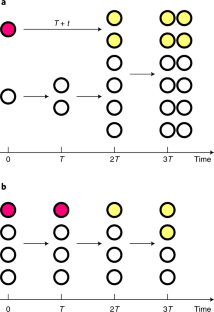2022-05-11 スウェーデン・リンショーピング大学
MYCが細胞内で行うことは、このタンパク質が300以上の他のタンパク質と相互作用していることに影響される。MYCの適応能力は、おそらくMYCが本質的に無秩序なタンパク質であり、電光石火で構造を変化させることができるという事実のおかげであろう。したがって、細胞内でのMYCの活性を調節する方法のひとつは、MYCと相互作用・協力関係にあるタンパク質との相互作用を中断させることかもしれない。
研究者らは最近、カナダの研究者と共同で、MYCと別のタンパク質との相互作用を詳細に調べ、細胞内のMYCの量に間接的に影響を与えるものを発見した。
ジャーナルNucleicAcidsResearchに最近発表された研究では、研究者は両方のタンパク質のどの部分がこの相互作用に直接関与しているのかを示しています。これらの領域は、腫瘍細胞におけるMYCの機能を妨げることを目的とした将来の薬剤の新しい興味深い標的を構成します。
<関連情報>
- https://liu.se/en/news-item/kemister-vill-stora-cancerrelaterat-protein
- https://academic.oup.com/nar/article/50/6/3505/6542486?login=false
MYCオンコプロテインはクロマチン補因子PNUTSと直接相互作用し、PP1ホスファターゼをリクルートする The MYC oncoprotein directly interacts with its chromatin cofactor PNUTS to recruit PP1 phosphatase
Yong Wei, Cornelia Redel, Alexandra Ahlner, Alexander Lemak, Isak Johansson-Åkhe, Scott Houliston, Tristan M G Kenney, Aaliya Tamachi, Vivian Morad, Shili Duan,David W Andrews, Björn Wallner, Maria Sunnerhagen, Cheryl H Arrowsmith, Linda Z Penn
Nucleic Acids Research Published:04 March 2022
DOI:https://doi.org/10.1093/nar/gkac138

Abstract
Despite MYC dysregulation in most human cancers, strategies to target this potent oncogenic driver remain an urgent unmet need. Recent evidence shows the PP1 phosphatase and its regulatory subunit PNUTS control MYC phosphorylation, chromatin occupancy, and stability, however the molecular basis remains unclear. Here we demonstrate that MYC interacts directly with PNUTS through the MYC homology Box 0 (MB0), a highly conserved region recently shown to be important for MYC oncogenic activity. By NMR we identified a distinct peptide motif within MB0 that interacts with PNUTS residues 1–148, a functional unit, here termed PNUTS amino-terminal domain (PAD). Using NMR spectroscopy we determined the solution structure of PAD, and characterised its MYC-binding patch. Point mutations of residues at the MYC-PNUTS interface significantly weaken their interaction both in vitro and in vivo, leading to elevated MYC phosphorylation. These data demonstrate that the MB0 region of MYC directly interacts with the PAD of PNUTS, which provides new insight into the control mechanisms of MYC as a regulator of gene transcription and a pervasive cancer driver.


